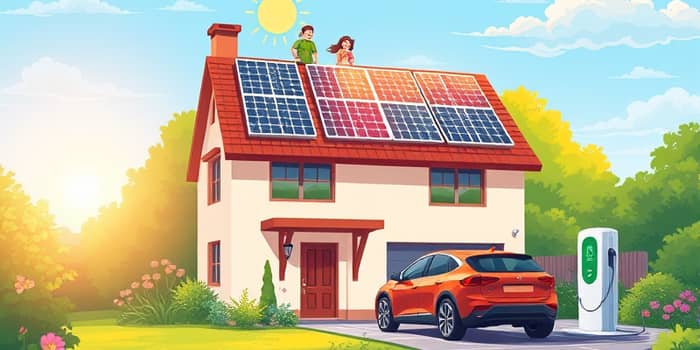In a world increasingly focused on sustainability, eco-friendly personal loans—often called green loans—offer individuals a powerful way to fund projects that benefit both their wallets and the planet. Whether you’re considering solar panels, energy-efficient appliances, or an electric vehicle, these specialized loans can make your green ambitions more attainable.
This article will provide a clear definition and sustainable opportunities behind green loans, guiding you through their benefits, application process, and future outlook. By understanding these financial tools, you can take meaningful action toward a more sustainable lifestyle.
What Are Eco-Friendly Personal Loans?
Eco-friendly personal loans are financial products specifically designed to fund projects or purchases that have a positive environmental impact. Unlike traditional personal loans, the funds are earmarked for initiatives such as renewable energy installations, energy-efficient home improvements, electric vehicle purchases, and other sustainable upgrades.
These loans serve a dual purpose: they enable borrowers to invest in greener living while fostering broader environmental benefits, including reduced carbon emissions and lower energy consumption communities. Eligibility typically requires proof that funds will be used for qualifying projects, often documented through receipts or project proposals.
Key Features of Green Loans
Green loans come with several distinctive features that set them apart from conventional lending options. Lenders often structure these products to incentivize eco-friendly behavior and ensure accountability in how funds are utilized.
- Purpose restriction: Funds must be applied to verifiable green projects or products.
- Competitive interest rates: Incentives for sustainable investments.
- Flexible repayment terms: Accommodating various project timelines.
- Documentation requirements: Evidence of project completion or product purchase.
- Eligibility criteria: Minimum credit score and income verification.
Many institutions offer more competitive interest rates for green loans compared to standard personal loans, encouraging borrowers to prioritize environmentally beneficial upgrades.
Benefits of Green Loans
Investing in green projects through specialized loans delivers a range of advantages, both financial and environmental. Borrowers can experience immediate and long-term gains that extend beyond individual savings.
- Environmental impact: Contribute to emission reductions and cleaner air.
- Cost savings: Lower utility bills and maintenance expenses over time.
- Financial incentives: Access to tax credits, rebates, and lower rates.
- Property value increase: Eco-friendly upgrades often boost home resale value.
With careful planning, homeowners and buyers can enjoy long-term reduction in utility bills, turning their green investments into durable financial benefits while promoting a healthier planet.
Example Use Cases and Real-World Impact
Green loans support a wide variety of practical applications that make day-to-day living more sustainable. Below are some of the most common and transformative use cases.
- Home solar power system installations and accompanying battery storage.
- Energy-efficient retrofits, including insulation, double-glazed windows, and heat pumps.
- Electric vehicle purchases and installation of at-home charging stations.
- Water conservation upgrades such as rainwater harvesting systems.
- Replacement of major appliances with ENERGY STAR® certified models.
- Eco-friendly renovations featuring sustainable materials and green roofs.
By choosing one or more of these projects, homeowners can achieve substantial environmental and cost savings, often recouping the investment through lower bills and government incentives over several years.
Comparing Green Loans, Bonds, and Sustainability-Linked Loans
While green loans focus on individual borrowers and specific projects, the broader green finance market includes bonds and sustainability-linked loans suited for institutional and corporate needs. The table below highlights key distinctions across these instruments.
This comparison underscores how individual green loans fit within a larger ecosystem of environmental financing, each serving unique needs and scales of investment.
How to Apply for an Eco-Friendly Personal Loan
Securing a green loan involves a straightforward process similar to traditional lending, with a few additional steps to verify the eco-friendly nature of your project.
First, research and select a lender—such as a bank, credit union, or fintech platform—that offers dedicated green loan products. Review their eligibility criteria and green financing guidelines to confirm your project qualifies.
Next, gather your documentation. Typically, you will need identity, income, and project documentation, which may include pay stubs, tax returns, and estimates or invoices for your green upgrade. Submit your application online or in person, undergo a credit check, and await approval.
Once approved, funds are disbursed directly to you or the vendor, ensuring that every dollar contributes to your sustainable initiative.
Challenges and Considerations
Despite their advantages, eco-friendly personal loans present certain challenges and nuances that borrowers should weigh carefully before applying for one.
Availability can be limited, as not all lenders offer green lending options in every region. Additionally, some lenders lack standardized criteria for qualifying green projects, which can make application guidelines complex and varied across institutions.
Documentation requirements may also be more stringent than standard loans, requiring post-project verification or periodic reporting. Finally, loan amounts and terms vary widely, so it’s essential to compare offers and assess the total cost of borrowing, including any fees or prepayment penalties.
The Future of Green Financing
Green finance is poised for continued growth as climate policy tightens and consumer demand for sustainable solutions rises. Regulatory clarity and enhanced reporting standards are expected to increase climate adaptation funding, creating more opportunities for individual borrowers and institutions alike.
In the coming years, personalization of loan products and personalized rates and better access for underserved communities may become more widespread, further democratizing the ability to invest in green technologies and efficient homes.
Conclusion
Eco-friendly personal loans represent a compelling bridge between personal finance and environmental stewardship. By leveraging specialized lending products, individuals can take concrete steps to reduce their carbon footprint while enjoying financial rewards and increased property values.
As the green finance sector evolves, staying informed about available products and incentives will empower you to make strategic, impactful investments. Embrace the opportunity to align your financial goals with the health of the planet—every green loan taken today paves the way for a more sustainable tomorrow.
References
- https://www.investopedia.com/what-is-a-green-loan-8696296
- https://www.discover.com/personal-loans/resources/learn-about-personal-loans/how-a-green-loan-can-help-you-save-money/
- https://www.aspiration.com/resources/what-is-a-green-loan
- https://www.bajajfinserv.in/green-loans
- https://lanterncredit.com/personal-loans/green-loans
- https://www.climatebonds.net/resources/press-releases/2025/01/climate-bonds-publishes-provisional-2024-numbers-and-key-factors
- https://www.investopedia.com/terms/g/green-bond.asp
- https://www.trethowans.com/insights/green-loans-social-loans-and-sustainability-linked-loans-what-are-they-and-how-could-they-benefit-you/










